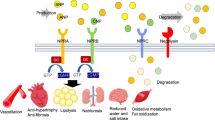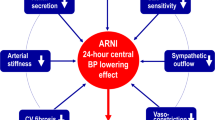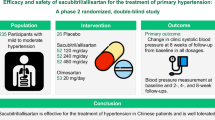Abstract
Poorly controlled hypertension is a major risk for cardiovascular morbidity and mortality, strokes, heart failure and renal failure. Despite these devastating complications, blood pressure control of ⩽140/90 mmHg, which is above the current standard, is very poor worldwide, accounting for 34% of hypertensive patients in the United States, and 6% in other countries. The reasons for this poor control of blood pressure include lack of aggressive treatment by physicians, especially for the systolic blood pressure, drug selection and patient compliance. The blood pressure follows a circadian rhythm and is the highest between 0600 to 1200 h, when most complications occur. Long-acting drugs that extend their action to cover this vulnerable period are preferable, especially those that block the renin–angiotensin–aldosterone system, such as ACE inhibitors and angiotensin receptor blockers, and are the most effective in controlling blood pressure and preventing or reducing its cardiovascular and renal complications. With respect to the angiotensin receptor blockers, telmisartan has been demonstrated by several studies to be the longest acting among its class of drugs and to effectively prevent the early morning rise of blood pressure.
This is a preview of subscription content, access via your institution
Access options
Subscribe to this journal
Receive 12 digital issues and online access to articles
$119.00 per year
only $9.92 per issue
Buy this article
- Purchase on Springer Link
- Instant access to full article PDF
Prices may be subject to local taxes which are calculated during checkout






Similar content being viewed by others
References
HE J, Whelton PK . Elevated systolic blood pressure and risk of cardiovascular and renal disease: overview of evidence from observational epidemiologic studies and randomized control trials. Am Heart J 1999; 138(Suppl 3): S211–S219.
Klag MJ et al. Blood pressure and end-stage renal disease in men. N Engl J Med 1996; 334: 13–18.
MacMahon S et al. Blood pressure, stroke and coronary heart disease: prolonged differences in blood pressure: prospective observational studies corrected for the regression dilution bias. Lancet 1990; 335: 765–774.
He J et al. Risk factors for congestive heart failure in US men and women. NHANES I epidemiologic follow-up study. Arch Intern Med 2001; 161: 996–1002.
Kannel WB . Blood pressure as a cardiovascular risk factor. Prevention and treatment. JAMA 1996; 275: 1571–1576.
Chobanian AV et al. The seventh Report of the Joint national Committee on Prevention, Detection, Evaluation and Treatment of High Blood Pressure. The JNC7 Report. JAMA 2003; 389: 2560–2572.
Marques-Vidal P, Tuomiletho J . Hypertension awareness, treatment and control in the community: is the rule of halvs still valid? J Hum Hypertens 1997; 11: 213–220.
Elliott WJ . Cyclic and circadian variations in cardiovascular events. Am J Hypertens 2001; 14: 291S–295S.
Chrysant SG . Vascular remodeling: the role of angiotensin converting enzyme inhibitors. Am Heart J 1998; 135: S21–S30.
Smolensky MH, Haus E . Circadian rhythms and clinical medicine with applications to hypertension. Am J Hypertens 2001; 14: 280S–290S.
White WB . Cardiovascular risk and therapeutic intervention for the early morning surge in blood pressure and heart rate. Blood Press Monit 2001; 6: 63–72.
Tanaka A et al. Circadian variation of plaque rupture in acute myocardial infarction. Am J Cardiol 2004; 93: 1–5.
Lonn EM et al. Emerging role of angiotensin-converting enzyme inhibitors in cardiac and vascular protection. Circulation 1994; 90: 2056–2069.
Yusuf S et al. Effects of an angiotensin-converting enzyme inhibitor, ramipril on cardiovascular events in high-risk patients. The Heart Outcomes Prevention Evaluation (HOPE) Study Investigators. N Engl J Med 2000; 342: 145–153.
Dahlof B et al. Cardiovascular morbidity and mortality in the Losartan Intervention For Endpoint reduction in hypertension study (LIFE): a randomized trial against atenolol. Lancet 2002; 359: 995–1003.
Vaughan Jr EP . Renin, angiotensin and aldosterone system in the pathogenesis and management of hypertensive vascular disease. Am J Med 1972; 52: 633–652.
Curtiss C et al. Role of the renin–angiotensin system in the systemic vasoconstriction of chronic congestive heart failure. Circulation 1978; 58: 763–770.
Garg R, Yusuf S, for the collaborative group of ACE inhibitor trials. Overview of randomized trials of angiotensin-converting enzyme inhibitors on mortality and morbidity in patients with heart failure. JAMA 1995; 273: 1450–1456.
Alderman MH et al. Association of the renin–sodium profile with the risk of myocardial infarction in patients with hypertension. N Engl J Med 1991; 324: 1098–1104.
Grossman E, Messerli FH, Neutel JM . Angiotensin II receptor blockers: equal or preferred substitutes for ACE inhibitors? Arch Intern Med 2000; 160: 1905–1911.
Garg R, Yusuf S, for the collaborative group of ACE inhibitor trials. Overview of randomized trials of angiotensin-converting enzyme inhibitors on mortality and morbidity in patients with heart failure. JAMA 1995; 273: 1450–1456.
Pfeffer MA et al. Effect of captopril on mortality and morbidity in patients with left ventricular dysfunction after myocardial infarction. Results of the survival and ventricular enlargement trial. The SAVE Investigators. N Engl J Med 1992; 327: 669–677.
The SOLVD Investigators. Effects of enalapril on survival in patients with reduced left ventricular ejection fractions and congestive heart failure. N Engl J Med 1991; 325: 293–302.
Pitt B et al. The effect of spironolactone on morbidity and mortality in patients with severe heart failure. Randomized Aldactone Evaluation Study (RALES) Investigators. N Engl J Med 1999; 341: 709–717.
Cohn JN, Tognoni G . Valsartan Heart Failure Trial Investigators. N Engl J Med 2001; 345: 1667–1675.
Townsend R, Haggert B, Liss C, Edelman JM . Efficacy and tolerability of losartan versus enalapril alone or in combination with hydrochlorothiazide in patients with essential hypertension. Clin Ther 1995; 17: 911–923.
Larochelle P et al. Effects and tolerability of irbesartan versus enalapril in patients with severe hypertension. Irbesartan Multicenter Investigators. Am J Cardiol 1997; 80: 1613–1615.
Ragot S et al. Comparison of trough effect of telmisartan vs perindopril using self blood pressure measurements: EVEREST Study. J Hum Hypertens 2002; 16: 865–873.
White WB . Comparative effects of telmisartan in the treatment of hypertension. J Clin Hypertens 2002; 4(Suppl 4): 20–25.
Tikkanen I, Omvik P, Jensen HA . Comparison of the angiotensin II antagonist losartan with the angiotensin converting enzyme inhibitor enalapril in patients with essential hypertension. J Hypertens 1995; 13: 1343–1351.
Zanchetti A, Omboni S, Biagio C . Candesartan cilexetil and enalapril are of equivalent efficacy in patients with mild to moderate hypertension. J Hum Hypertens 1997; 11(Suppl 2): S57–S59.
Gavras I, Gavras H . Effects of eprosartan versus enalapril in hypertensive patients on the renin–angiotensin–aldosterone system and safety parameters: results from the 26-week, double-blind, multicentre study. Eprosartan Multinational Study Group. Curr Med Res Opin 1999; 15: 15–24.
Dzau VJ, Sasamura H, Hein L . Heterogencity of angiotensin synthetic pathways and receptor subtypes: physiological and pharmacological implications. J Hypertens 1993; 11(Suppl 3): S13–S18.
Hollenberg NK, Fisher ND, Price DA . Pathways for angiotensin II generation in intact human tissue: evidence from comparative pharmacological interruption of the renin system. Hypertension 1998; 32: 387–392.
Takai S, Jin D, Sakguchi M, Miyazaki M . Chymase-dependent angiotensin II formation in human vascular tissue. Circulation 1999; 100: 654–658.
Ihara M et al. Increased chymase dependent angiotensin II formation in human atherosclerotic aorta. Hypertension 1999; 33: 1399–1405.
Dunselman PH . Effects of the replacement of the angiotensin converting enzyme inhibitor enalapril by the angiotensin II receptor blocker telmisartan in patients with congestive heart failure. The replacement of angiotensin converting enzyme inhibition (REPLACE) investigators. Int J Cardiol 2001; 77: 139–140.
Wienen W et al. A review on telmisartan: a novel, long-acting angiotensin II-receptor antagonist. Cardiovasc Drug Rev 2000; 18: 127–156.
Unger T . Pharmacology of AT1-receptor blockers. Blood Pressure 2001; 10(Suppl 3): 5–10.
Siragy HM . Angiotensin receptor blockers: how important is selectivity? Am J Hypertens 2002; 15: 1006–1014.
Siragy HM, Carey RM . The subtype-2 (AT2) angiotensin receptor regulates renal cyclic quanosine 31,51-monophosphate and AT2 receptor mediated prostaglandin E2 production in conscious rats. J Clin Invest 1996; 97: 1978–1982.
Siragy HM, Carey RM . The subtype-2 (AT2) angiotensin receptor mediates renal production of nitric oxide in conscious rats. J Clin Invest 1997; 100: 264–269.
Gohlke P, Pees C, Unger T . AT2 receptor stimulation increases cyclic GMP in SHRSP by a kinin-dependent mechanism. Hypertension 1998; 31: 349–355.
Mallion JM, Siche JP, Lacourciere Y, and the Telmisartan Blood Pressure Monitoring Group. ABPM comparison of the antihypertensive profiles of the selective angiotensin II receptor antagonists, telmisartan and losartan in patients with mild-to-moderate hypertension. J Hum Hypertens 1999; 13: 657–664.
Neutel JM, Smith DHG . Evaluation of angiotensin II receptor blocker for 24-hour blood pressure control: meta-analysis of a clinical database. J Clin Hypertens 2003; 5: 58–63.
Lacourciere Y et al. A comparison of the efficacies and duration of action of the angiotensin II receptor blocker telmisartan and amlodipine. Blood Press Monit 1998; 3: 295–302.
Freytag F et al. Comparison of 26-week efficacy and tolerability of telmisartan and atenolol, in combination with hydrochlorothiazide as required, in the treatment of mild-to-moderate hypertension: a randomized, multi-center study. Clin Ther 2001; 23: 108–123.
Smith DHG, Neutel JM, Morgenstern P . Once-daily telmisartan compared with enalapril in the treatment of hypertension. Adv Ther 1998; 15: 229–240.
Neutel JM et al. Comparison of telmisartan with lisinopril in patients with mild-to-moderate hypertension. Am J Ther 1999; 6: 161–166.
McGill JB, Reilly PA . Combination treatment with telmisartan and hydrochlorothiazide in black patients with mild-to-moderate hypertension. Clin Cardiol 2001; 24: 66–72.
McGill JB, Reilly PA . Telmisartan plus hydrochlorothiazide mono-therapy in patients with mild-to-moderate hypertension: a multicenter, randomized, double-blind, placebo-controlled, parallel group trial. Clin Ther 2001; 23: 833–850.
Lacourciere Y et al. Efficacy and tolerability of a fixed dose combination of telmisartan plus hydrochlorothiazide in patients uncontrolled with telmisartan monotherapy. J Hum Hypertens 2001; 13: 763–770.
Lacourciere Y, Martin K . Comparison of a fixed dose combination of telmisartan 40 mg plus hydrochlorothiazide 12.5 mg with telmisartan 40 mg in the control of mild-to-moderate hypertension. Am J Ther 2002; 9: 111–117.
Thybo NK et al. Effect of antihypertensive treatment on small arteries of patients with previously untreated essential hypertension. Hypertension 1995; 25: 474–481.
Zihm I et al. Regression of media to lumen ratio of human subcutaneous arteries and left ventricular hypertrophy during treatment with an angiotensin converting enzyme inhibitor-based regimen in hypertensive patients. Am J Cardiol 1995; 76: 38E–40E.
PROGRESS Collaborative Group. Randomized trial of a perindopril-based blood pressure lowering regimen among 6,105 individuals with previous stroke or transient ischemic attack. Lancet 2001; 358: 1033–1041.
Wing LMH et al. A comparison of outcomes with angiotensin-converting-enzyme inhibitors and diuretics for hypertension in the elderly. N Eng J Med 2003; 348: 583–592.
Thurman PA et al. Influence of the angiotensin II antagonist valsartan on left ventricular hypertrophy in patients with essential hypertension. Circulation 1998; 98: 2037–2042.
Malmgvist K et al. Long-term effects of irbesartan and atenolol on the renin–angiotensin–aldosterone system in human primary hypertension: the Swedish Irbesartan Left Ventricular Hypertrophy Investigation versus Atenolol (SLVHIA). J Cardiovasc Pharmacol 2003; 42: 719–726.
Cuspidi C et al. Comparative effects of candesartan and enalapril on left ventricular hypertrophy in patients with essential hypertension: the Candesartan Assessment in the Treatment of Cardiac Hypertrophy (CATCH) study. Hypertension 2002; 20: 2293–2300.
Yusuf S . From the HOPE to the ONTARGET and the TRANSCEND studies: challenges in improving prognosis. Am J Cardiol 2002; 89(Suppl): 18A–26A.
Pfeffer MA, et al, for the Valsartan in Acute Myocardial Infarction Trial (VALIANT) investigators. Valsartan, captopril, or both in myocardial infarction complicated by heart failure, left ventricular dysfunction, or both. N Engl J Med 2003; 349: 1893–1906.
Giatras I, Lau J, Levery AS . The effect of angiotensin-converting-enzyme inhibitors on progression of non-diabetic renal disease: a meta-analysis of randomized trials. Ann Intern Med 1997; 127: 337–345.
Maschio G et al. For the angiotensin-converting-enzyme inhibition in progressive renal insufficiency study group. Effect of the angiotensin-converting-enzyme inhibitor benazepril on the progression of chronic renal insufficiency. N Engl J Med 1996; 334: 939–945.
Wright JT et al. Effect of blood pressure lowering and antihypertensive drug class on progression of hypertensive kidney disease: results from the AASK trial. JAMA 2002; 288: 2421–2431.
Lewis EJ et al. The effect of angiotensin-converting-enzyme inhibitor on diabetic nephropathy. N Engl J Med 1993; 329: 1456–1462.
Bakris GL, Weir M . ACE inhibitors and protection against kidney disease progression in patients with type-2 diabetes: what's the evidence. J Clin Hypertens 2002; 4: 420–423.
Viberti G, Wheeldon NM, for the Micro-Albuminuria Reduction with Valsartan (MARVAL) Study Investigators. Micro-albuminuria reduction with valsartan in patients with type-2 diabetes mellitus. A blood pressure-independent effect. Circulation 2002; 106: 672–678.
Opie LH . Renoprotection by angiotensin receptor blockers and ACE inhibitors in hypertension. Lancet 2001; 358: 1829–1831.
Lewis EJ et al. Renoprotective effect of the angiotensin receptor antagonist irbesartan in patients with nephropathy due to type-2 diabetes. N Engl J Med 2001; 345: 851–860.
Brenner BM, et al, for the RENAAL Study Investigators. Effects of losartan on renal and cardiovascular outcomes in patients with type-2 diabetes and nephropathy. N Engl J Med 2001; 345: 861–869.
Goligorsky MS, Chen J, Brodsky S . Endothelial cell dysfunction leading to diabetic nephropathy: focus on nitric oxide. Hypertension 2001; 37: 744–748.
Opie LH, Parving HH . Diabetic nephropathy. Can renoprotection be extrapolated to cardiovascular protection? Circulation 2002; 106: 643–645.
Wachtel K et al. Albuminuria and cardiovascular risk in hypertensive patients with left ventricular hypertrophy: The LIFE study. Ann Intern Med 2003; 139: 901–906.
Rippin J, Bain SC, Barnett AI, DETAIL Study. Rationale and design of diabetics exposed to telmisartan and enalopril (DETAIL) study. J Diabetes Complications 2002; 16: 195–200.
Pitt B et al. Effects of losartan compared with captopril on mortality in patients with symptomatic heart failure: randomized trial. The Losartan Heart Failure Survival study (ELITE II). Lancet 2000; 355: 1582–1587.
Dickstein K, Kjekshaus J, OPTIMAAL Steering Committee of the OPTIMAAL study. Effects of losartan and captopril on mortality and morbidity in high-risk patients after acute myocardial infarction: the OPTIMAAL randomized trial. Optimal Trial in Myocardial infarction with Angiotensin II Antagonist Losartan. Lancet 2002; 360: 752–760.
Dickstein K . What did we learn from the OPTIMAAL trial? What can we expect from VALIANT? Am Heart J 2003; 145: 754–756.
Cohn JN, Tognoni G . Valsartan Heart Failure Trial (Val-HeFT) investigators. A randomized trial of the angiotensin receptor blocker valsartan in chronic heart failure. N Engl J Med 2001; 345: 1667–1675.
Wong M et al. Valsartan benefits left ventricular structure and function in heart failure. Val-HeFT echocardiographic study. J Am Coll Cardiol 2002; 40: 970–975.
McMurray JJ et al. Effects of candesartan in patients with chronic heart failure and reduced left ventricular systolic function taking angiotensin-converting-enzyme inhibitors: the CHARM-Added trial. Lancet 2003; 362: 767–771.
Granger CB et al. Effects of candesartan in patients with chronic heart failure and reduced left ventricular systolic function intolerant to angiotensin-converting-enzyme inhibitors: the CHARM-Alternative trial. Lancet 2003; 362: 772–776.
Pfeffer MA, et al, for the Valsartan in Acute Myocardial Infarction Trial (VALIANT) investigators. Valsartan, Captopril, or Both in Myocardial Infarction Complicated by Heart Failure, Left Ventricular Dysfunction or Both. N Engl J Med 2003; 349: 1893–1906.
Oparil S et al. Comparative efficacy of olmesartan, losartan, valsartan, and irbesartan in the control of essential hypertension. J Clin Hypertens 2001; 3: 283–291.
Sharpe M, Jarvis B, Goa KL . Telmisartan: a review of its use in hypertension. Drugs 2001; 6: 1501–1529.
ALLHAT Officers and Coordinators for the ALLHAT Collaborative Research Group. Major outcomes in high-risk hypertensive patients randomized to angiotensin-converting-enzyme inhibitor or calcium channel blocker vs diuretic: The Antihypertensive and Lipid-Lowering Treatment to Prevent Heart Attack Trial (ALLHAT). JAMA 2002; 288: 2981–2997.
Chrysant SG et al. Racial differences in pressure volume and renin inter-relationships in essential hypertension. Hypertension 1979; 1: 136–141.
Douglas JG et al. Management of high blood pressure in African Americans. Consensus statement of the hypertension in African Americans working group of the international society of hypertension in blacks. Arch Intern Med 2003, 525–541.
American Diabetes Association. Diabetic nephropathy. Diabetes Care 2002; 25(Suppl 1): S85–S89.
Author information
Authors and Affiliations
Corresponding author
Rights and permissions
About this article
Cite this article
Chrysant, S., Chrysant, G. & Desai, A. Current status of angiotensin receptor blockers for the treatment of cardiovascular diseases: focus on telmisartan. J Hum Hypertens 19, 173–183 (2005). https://doi.org/10.1038/sj.jhh.1001808
Received:
Accepted:
Published:
Issue Date:
DOI: https://doi.org/10.1038/sj.jhh.1001808
Keywords
This article is cited by
-
Antihypertensive und metabolische Effekte von Telmisartan bei Patienten mit metabolischem Syndrom in der Praxis – eine Anwendungsbeobachtung
Wiener Medizinische Wochenschrift (2007)



